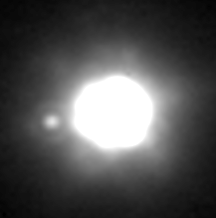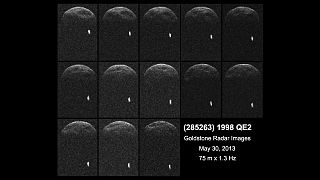Related Research Articles

762 Pulcova is a main-belt asteroid. It was discovered by Grigoriy N. Neujmin in 1913, and is named after Pulkovo Observatory, near Saint Petersburg. Pulcova is 137 km in diameter, and is a C-type asteroid, which means that it is dark in colouring with a carbonate composition.

Hermione is a very large binary asteroid discovered in 1872. It orbits in the Cybele group in the far outer asteroid belt. As an asteroid of the dark C spectral type, it is probably composed of carbonaceous materials. In 2002, a small moon was found to be orbiting Hermione.

5261 Eureka is the first Mars trojan discovered. It was discovered by David H. Levy and Henry Holt at Palomar Observatory on 20 June 1990. It trails Mars (at the L5 point) at a distance varying by only 0.3 AU during each revolution (with a secular trend superimposed, changing the distance from 1.5–1.8 AU around 1850 to 1.3–1.6 AU around 2400). Minimum distances from Earth, Venus, and Jupiter, are 0.5, 0.8, and 3.5 AU, respectively.

Roxane is an asteroid from the asteroid belt approximately 19 km in diameter. It was discovered by Auguste Charlois from Nice on September 11, 1891. The name was chosen by F. Bidschof, an assistant at the Vienna Observatory, at Charlois' request; Bidschof chose to name it after Roxana, the wife of Alexander the Great, and at first used the spelling "Roxana".

705 Erminia is a minor planet orbiting the Sun. Its name derives from the comic opera Erminie. An occultation on 8 December 2014 gave 3 chords, with one measurement suggesting a small moon 6-10 kilometers wide at a distance of 400 kilometers to the primary.
854 Frostia is a main-belt asteroid orbiting the Sun. It was discovered in 1916 by Sergei Ivanovich Belyavsky from Simeiz Observatory in Crimea and is named after Edwin Brant Frost, an American astronomer. This asteroid measures approximately 8.4 km (5.2 mi) in diameter.
5381 Sekhmet is an Aten asteroid whose orbit is sometimes closer to the Sun than the Earth's. Carolyn Shoemaker at Palomar Observatory discovered it on 14 May 1991. It is named after Sekhmet, the Egyptian goddess of war.
6708 Bobbievaile, provisional designation 1989 AA5, is a stony background asteroid and asynchronous binary system from the inner regions of the asteroid belt, approximately 8 kilometers (5 miles) in diameter. It was discovered on 4 January 1989, by Australian astronomer Robert McNaught at the Siding Spring Observatory in New South Wales, Australia. It is named after Bobbie Vaile.
21436 Chaoyichi provisional designation 1998 FL116, is a background asteroid and binary system from the inner region of the asteroid belt, approximately 2 kilometers in diameter. It was discovered on 31 March 1998, by astronomers of the Lincoln Near-Earth Asteroid Research at Lincoln Laboratory's Experimental Test Site near Socorro, New Mexico, United States.
3034 Climenhaga is a stony Florian asteroid and synchronous binary asteroid from the inner regions of the asteroid belt, approximately 7.8 kilometers in diameter. The asteroid was discovered on 24 September 1917 by German astronomer Max Wolf at Heidelberg Observatory in southwest Germany and assigned provisional designation A917 SE. It was later named after Canadian astrophysicist John Climenhaga. Its minor-planet moon has a period of nearly 19 hours.
2754 Efimov, provisionally named 1966 PD, is a stony asteroid and binary system from the inner regions of the asteroid belt, approximately 5 kilometers in diameter. It was discovered on 13 August 1966, by Russian astronomer Tamara Smirnova at the Crimean Astrophysical Observatory in Nauchnyj, on the Crimean peninsula. The asteroid was named after Russian aviator Mikhail Efimov.
3073 Kursk, provisionally known as 1979 SW11, is a stony Florian asteroid and synchronous binary system from the inner regions of the asteroid belt, approximately 4.7 kilometers in diameter. It was discovered on 24 September 1979, by Soviet astronomer Nikolai Chernykh at the Crimean Astrophysical Observatory in Nauchnyj, on the Crimean peninsula.
7958 Leakey, provisional designation 1994 LE3, is a Hungaria asteroid and synchronous binary system from the inner regions of the asteroid belt, approximately 3 kilometers in diameter.
2121 Sevastopol, provisional designation 1971 ME, is a stony Florian asteroid and synchronous binary system from the inner regions of the asteroid belt, approximately 10 kilometers in diameter. It was discovered on 27 June 1971, by Russian astronomer Tamara Smirnova at the Crimean Astrophysical Observatory in Nauchnij, on the Crimean peninsula. Its minor-planet moon was discovered in 2010.
8373 Stephengould is an outer main-belt binary asteroid discovered on 1 January 1992 by Carolyn S. Shoemaker and Eugene Merle Shoemaker at Palomar Observatory. The asteroid was named after the Harvard paleontologist Stephen Jay Gould. The asteroid has a very high inclination, having the second highest inclination of any of the first 10,000 discovered asteroids in the asteroid belt, after 2938 Hopi.
2623 Zech, provisional designation A919 SA, is a stony binary asteroid from the inner regions of the asteroid belt, approximately 6.5 kilometers in diameter. It was discovered on 22 September 1919, by German astronomer Karl Reinmuth at Heidelberg Observatory in southwest Germany. It was named after German ARI astronomer Gert Zech.
3951 Zichichi, provisional designation 1986 CK1, is a stony Florian asteroid and binary system from the inner regions of the asteroid belt, approximately 7 kilometers in diameter. It was discovered on 12 February 1986, by staff members at the San Vittore Observatory near Bologna, Italy, and named after physicist Antonino Zichichi.
2486 Metsähovi, provisional designation 1939 FY, is a stony asteroid and synchronous binary system from the inner regions of the asteroid belt, approximately 10 kilometers in diameter. It was discovered on 22 March 1939, by Finnish astronomer Yrjö Väisälä at the Turku Observatory.

(285263) 1998 QE2, provisional designation 1998 QE2, is a dark asteroid and synchronous binary system, classified as near-Earth object and potentially hazardous asteroid of the Amor group, approximately 3 kilometers in diameter. It was discovered on 19 August 1998, by astronomers of the LINEAR program at Lincoln Laboratory's Experimental Test Site near Socorro, New Mexico, in the United States. Its sub-kilometer minor-planet moon was discovered by radar on 30 May 2013.
(31345) 1998 PG is an eccentric, stony asteroid and binary system, classified as near-Earth object of the Amor group of asteroids, approximately 900 meters in diameter. It minor-planet moon, S/2001 (31345) 1, has an estimated diameter of 270 meters.
References
- 1 2 3 "JPL Small-Body Database Browser: 15430 (1998 UR31)" (2015-01-28 last obs.). Jet Propulsion Laboratory . Retrieved 5 April 2016.
- ↑ Johnston, Robert. "(15430) 1998 UR31". johnstonsarchive.net. Retrieved 29 May 2015.